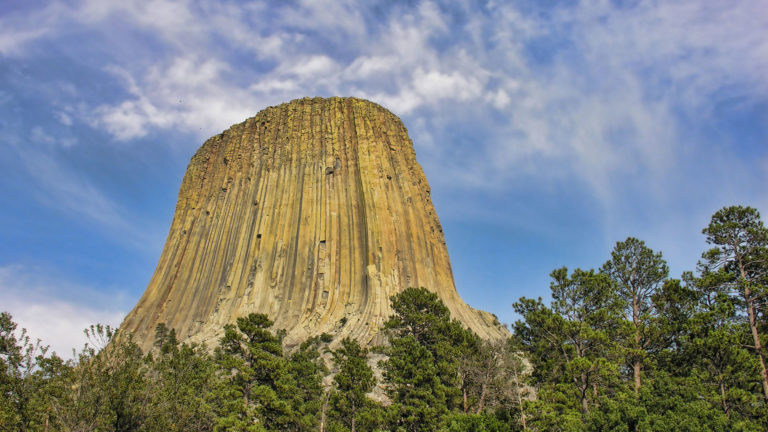Devils Tower is a striking laccolithic butte in northeastern Wyoming near Hulett and Sundance. It is a popular attraction for rock climbers, hikers, and curious tourists with the summit rising an astounding 1,267 feet above the Belle Fourche River.
History
The monolith was named “Devils Tower” in 1875 during an expedition led by Colonel Richard Irving Dodge. His interpreter misinterpreted the native name to mean “Bad God’s Tower.” Native names for Devils Tower are varied and range from “Home of the Bear” to “Brown Buffalo Horn” to “Tree Rock”. Dodge was enchanted by the tower and called it “one of the most remarkable peaks in this, or any, country.”
In September 1906, Devils Tower became the first National Monument through the work of Theodore Roosevelt. The monument began a popular spot for camping, picnicking, and celebrations. A 4th of July celebration was held at the Tower in 1893. At this event, the Tower was climbed for the first time by a local rancher, William Rogers. People came from hundreds of miles around to witness the climb and spectators numbered about 1000. William’s wife completed the climb two years later, making her the first woman to reach the top.
In the 1930s, it became a popular attraction from tourists around the nation, due to the improvement of transportation and wide publicity.
Native American Lore
Devils Tower is an important site for several Native American tribes.
In his history of the tower, historian Ray H. Mattison described one of the native legends about the creation of Devils Tower.
“According to the Kiowas, who at one time are reputed to have lived in the region, their tribe once camped on a stream where there were many bears. One day seven little girls were playing at a distance from the village and were chased by some bears. The girls ran toward the village and when the bears were about to catch them, they jumped to a low rock about three feet in height. One of them prayed to the rock, “Rock, take pity on us — Rock, save us.” The rock heard them and began to elongate itself upwards, pushing the children higher and higher out of reach of the bears. When the bears jumped at them they scratched the rock, broke their claws and fell back upon the ground. The rock continued to push the children upward into the sky while the bears jumped at them. The children are still in the sky, seven little stars in a group (the pleiades). According to the legend the marks of the bear’s claws may be seen on the side of the rock.”
There is a voluntary climbing ban for the month of June to respect Native American ceremonies around the monument that take place during this month. Approximately 85% of climbers respect this ban.
Rock Climbing
Devils Tower has become a popular rock climbing destination. About one percent of the nearly 400,000 annual visitors climb the Tower. The most commonly used route is the Durrance Route, established in 1938. However, there are a number of climbs around the Tower ranging anywhere from easy to some of the hardest in the world. All climbers must register with a ranger before beginning the ascent.
Hiking
The park has a number of quality trails that give visitors excellent views of the Tower. The most popular hike is the 1.3 mile Tower Trail. This paved trail goes around the base of the Tower. It goes through a Ponderosa Pine forest and boulder field. Other trails include the Red Beds Trail, a 2.8 mile loop; the Joyner Ridge Trail, a 1.5 mile loop; and the South Side/Valley View Trails, a 1.5 mile circuit. Pets are not allowed on trails in the park.
Entrance fees are $15 per private vehicle, $10 per motorcycle, and $5 per pedestrian or cyclists. There is an annual pass available for $30.

